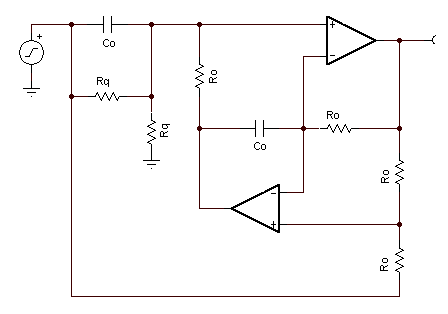
The filter topology here is the Fliege topology. I have found this to be the most stable and most easily tuned notch filter topology. I am aware a lot of people use the "Twin-T" toplogy, which has the advantage of being a single op-amp topology. It is much harder to tune, however.
Tuning can be done by varying the Ro inside the loop connected to the inverting inputs of the op amps. This filter will produce a notch of maximum depth allowed by op amp bandwidth and real world parasitics at some frequency. If you want to trim, select the next lower standard resistance value and place a pot in series with it, a pot that equals twice the gap between standard resistor values in the vicinity of the fixed resistor you are using. The two Ro's connected to the non-inverting input should be matched. Mis-matches will affect notch depth.
The Q setting is preset to 10, which only means that the -3 dB points of the filter will be at spaced at +/- 5% of the center frequency. This has little meaning for a notch, you are after the center frequency. Still, it is a way of knowing how much you will disturb the frequencies around the center. Q's of 1 are ridiculous - you would be better off with a wide band reject filter. Q's of 100 start eroding the notch depth, the bandwidth of the op amp comes into play. So 10 is a really good value - stick with it unless you really know what you are doing.
